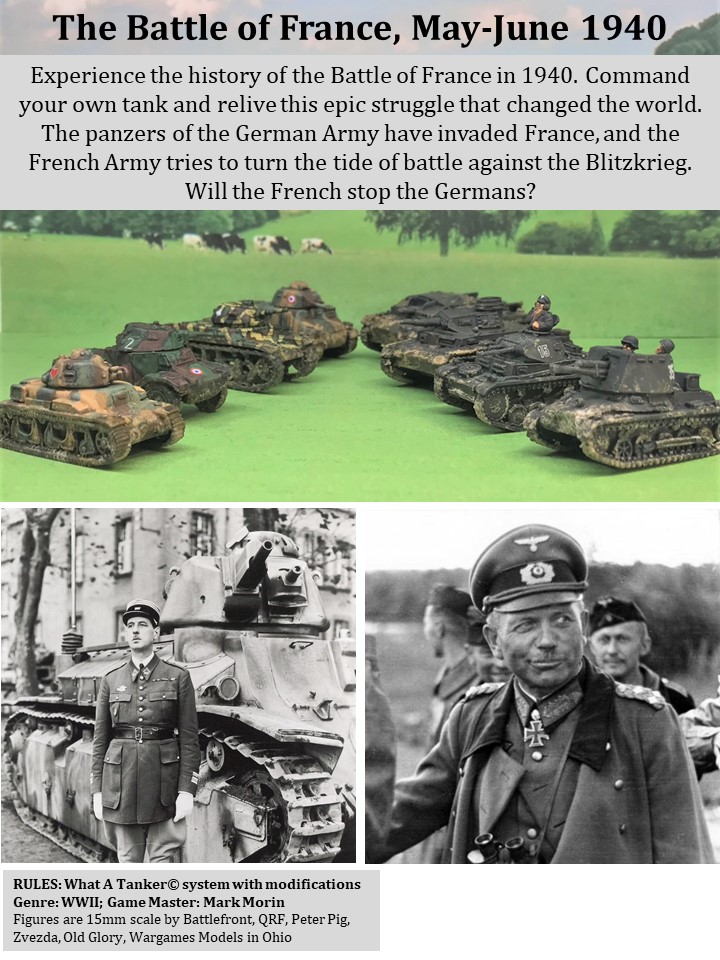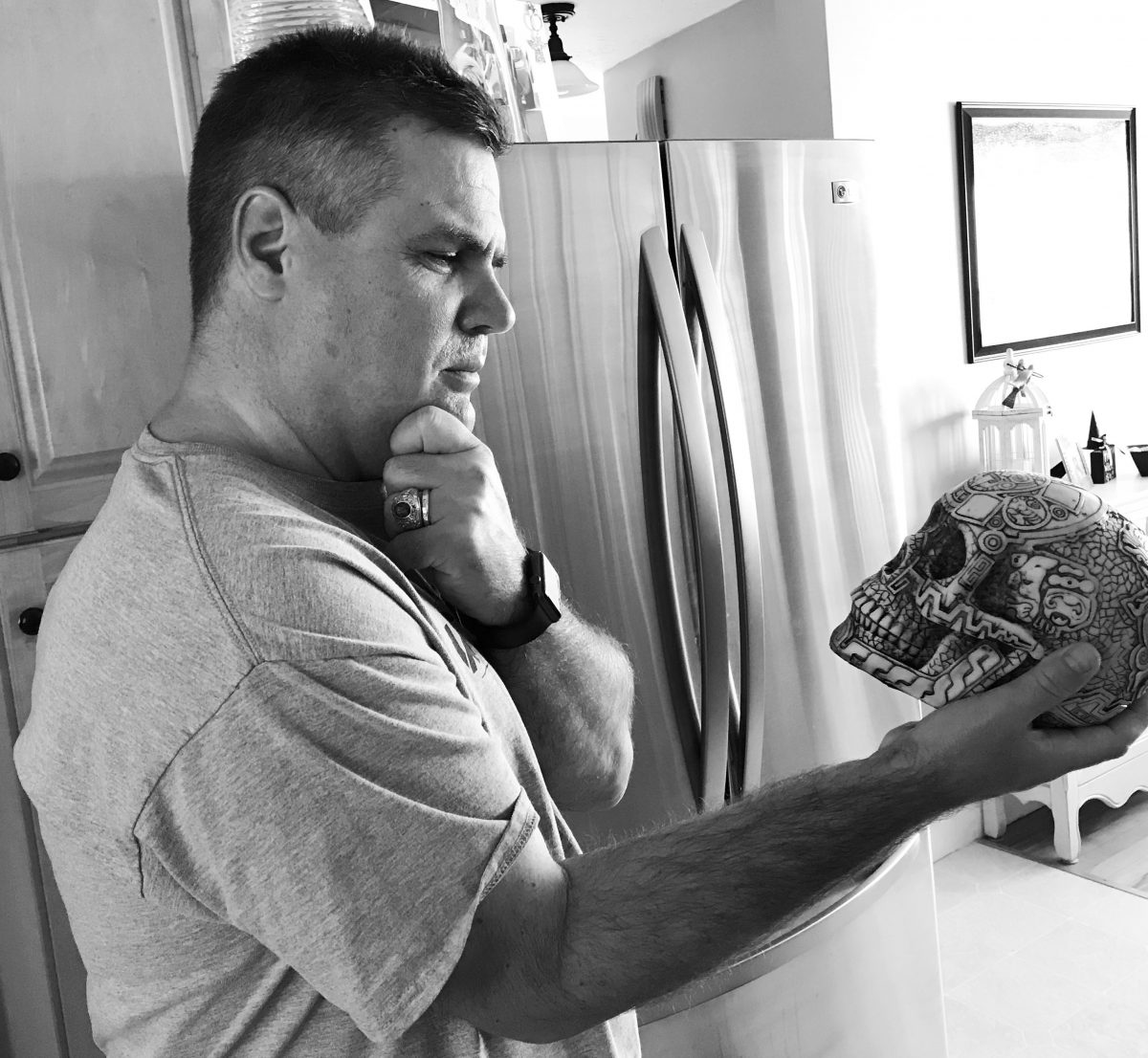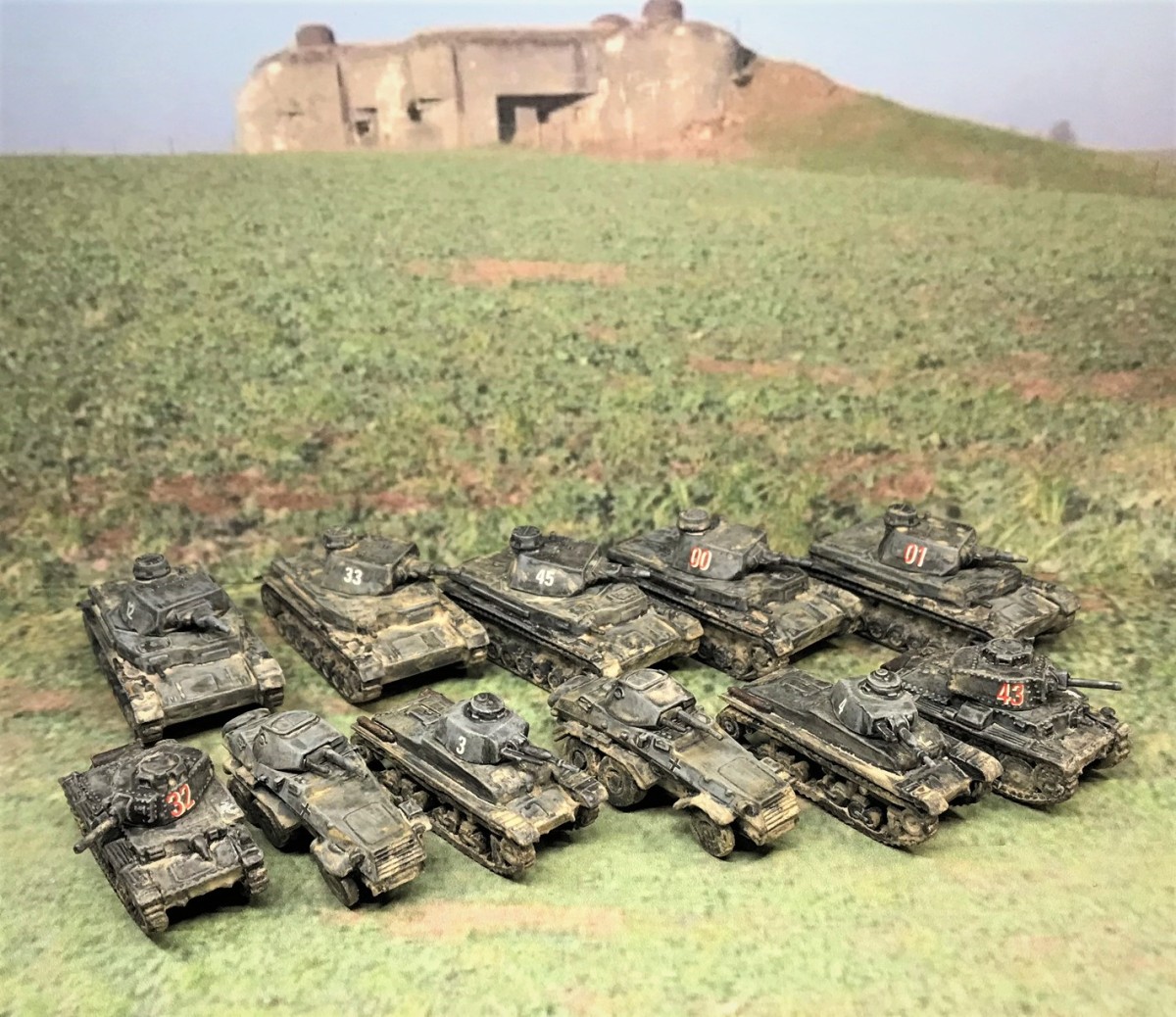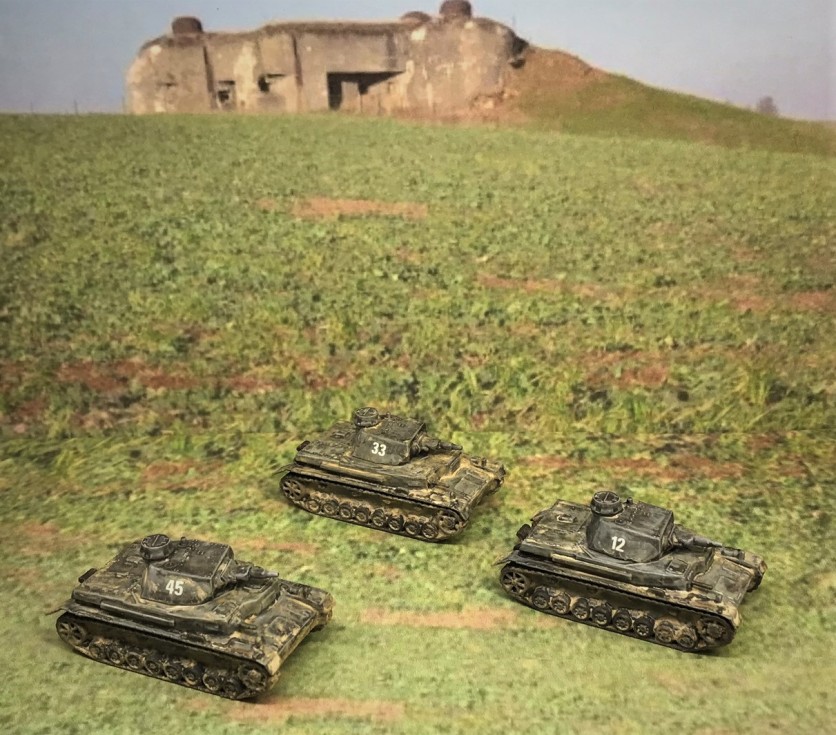This post marks the last of my vehicle additions for the 80th Anniversary of the Battle of France in May-June 1940. These German vehicles were completed in late January, but with my personal situation, naturally my posting and hobby activities were put on hold. Time has passed now and I want to return to a certain degree of normalcy – of course that’s not the easiest thing to do. But I’ll try – and now let’s catch up and get back to good old hobby stuff.
As readers of this blog know, I had needed to augment the depth and breadth of my 15 mm/1:100 scale armor (both sides) for my What a Tanker© Battle of France 1940 scenario. I also wanted to develop some Bonus Attack cards for it as well (similar to what I did with my Normandy Breakout! scenario). I had promised to get these projects covered on the blog and share some about games that I have run for them (at club days and the TotalCon convention). Here, I will focus here uniquely on these German vehicles and the Bonus Attack Cards and post about the gaming events separately.
Below is my poster for the game that I use at convention-style events.

Previously, I had posted and described several projects in support of building this scenario – here they are for reference:
- French Armor for the 80th Anniversary of the Battle of France: AMC 35 Cavalry Tanks; Char D2, R40, FT17 Infantry Tanks; and Panhard 178 Armored Cars
- French Armor for the 80th Anniversary of the Battle of France: Hotchkiss H35 and H39 Light Cavalry Tanks
- French FCM 36 tanks
- Happy Tanksgiving! 2 Soviet, 5 French, and 5 German tanks get off the November painting table for “What A Tanker” games
Basically, prior to this project I had only 11 German vehicles for the scenario, and the mix was a bit unbalanced to say the least. I had 4 Panzer IIC’s, 1 Panzer IIIE, 1 Panzerjäger I, 2 Panzer IVD’s, and 3 Sturmgeschutz A’s. Now that I have 23 French vehicles, I needed to increase the size of the available German vehicles for the scenario.
Back in May-June 1940, Panzer I’s and Panzer II’s did form a large proportion of the German armored forces in May-June 1940. As Panzer I’s have only machine guns, which are somewhat useless in a tank-on-tank game). As I have 4 Panzer IIC’s in the inventory, I decided to augment the light tanks with Panzer 35(t)’s and Panzer 38(t)’s. These were originally built for the Czechoslovakian Army, and the Wehrmacht happily incorporated these vehicles into their units – and continued building the both after the annexation. I got two metal Panzer 35(t) models (#GFV28) from QRF in the UK, and two metal and resin Panzer 38(t) models (#GE022) from Battlefront. Perhaps later on I might add a Panzer I, we’ll see.
For the medium tanks, I “assigned” (for game purposes) my two currently-painted Wargame Models in Ohio Panzer IVD’s into ausf A versions – and added B and D variants of the venerable Panzer IV with Zvezda models (SKU #ZD35 or #6151 for each box) from The Plastic Soldier Company. PSC has a reasonable deal for a platoon of 5 so I grabbed those. I already have one Panzer IIIE model for France 1940, and decided that was enough of those (for now anyways).
Lastly, similar to what I did with the French Panhard 178’s , I added 2 Sd.Kfz. 231 (6-rad) armored cars (#GE320) from Battlefront. I know that the 8-wheeled versions were available and used in May 1940. However, at the time the 6-wheel 231’s were being phased out in favor of the 8-wheeled versions – and I thought having the older ones would give a better feel to the scenario. By building these models and converting the ones mentioned, I now have 23 vehicles available for both sides to choose. I will go through a bit of a WIP with each type – as I did experiment a bit with contrast paints on them – to a bit of frustration which I will share. I’ll also show the Bonus Attack Cards, some eye-candy shots, references, and list of paints for those interested.
General Assembly
The QRF Panzer 35(t) models were all metal, the Battlefront Panzer 38(t) and Sd.Kfz. 231 (6-rad) models were metal and resin, and the Zvezda Panzer IV’s were plastic. I cleaned and prepped them all prior to assembly and painting, to include magnetizing the turrets. Some green stuff reinforcement and repair was needed. My overall goal was to have vehicles that were more grey and less dark than my previous German vehicles for 1940. The dark colors were also historically correct – I just wanted a bit more variety in the collection that was also historically correct.




The painting process was a bit different for me this time. I basically did this sequence with all 11 vehicles. I wanted to test out the contrast paints, so I decided to try the “Space Wolves Grey” contrast paint over Vallejo “German Panzer Grey” primer – and the chassis were nearly purple.

I then went back and dry brushed them with Vallejo “White” primer, then used “Apothecary White” contrast paint and dry brushed with a few more grays and added some shading (see the list at the end of this post).



For weathering, I used Vallejo pigments – a combination/blend of two pigments on these with a makeup brush for dusting effect.

Then I varnished the tanks with Vallejo Mecha Color “Matt Varnish”. Now, let’s look at each type in brief.
Panzer 35(t)
These were originally built by Skoda. The (t) stands for the German word for Czech, which is tschechisch. The Germans had 244 of these after the annexation, and used them in both the invasion of Poland and of France. Around 132 were involved in the Battle of France, and they served in the Wehrmacht through the invasion of the USSR until the summer of 1941. By that time, there were no more spare parts being made, was performing badly in the cold, and it was badly obsolete. Some were then converted to other uses, and some sold to Romania.
The Panzer 35(t) had a reasonably good (for 1940) 37 mm gun capable of penetrating 30 mm of armor. It was a light tank, and had maximum frontal armor of 25 mm, with 15-16 mm on the side, 15-19 mm on the rear, and 8 mm on the top. This allowed better speed and greater range than most French contemporaries, with a top speed of 21 mph and a range of 120 miles from its 120 hp 4-cylinder engine. The chassis armor was riveted together. It did have a radio.
Panzer 38(t)
The Panzer 38(t) was another Czech “acquisition” as it were. It was designed and built by CKD. Over the course of the war, the Germans had over 1,400 – of which only about a hundred were used in France.
The Panzer 38(t) had a better 37 mm gun than the Panzer 35(t). That gun was capable of penetrating 36-59 mm of armor. It also was a light tank, with a (in 1940) maximum frontal armor of 30 mm. It also had much better speed and greater range than most French (and some German) contemporaries, with a top speed of 26 mph and a range of 160 miles from its 123.3 hp 6-cylinder engine. The chassis armor was riveted together, and the tank had a radio. The tank itself was used by the Germans until 1942, and the chassis was reused for many other vehicles, notably the Grille and the Hetzer, as well as being exported to Sweden (who also built them under license), Slovakia, Romania, and even Peru. Peru also had acquired some from Czechoslovakia and used them in combat in South America versus Ecuador in 1941 in the Ecuadorian-Peruvian War as well as 50 years later against the Shining Path insurgents.

Panzer 38(t) turrets late in project

Sd.Kfz. 231 (6-rad)
Most modelers and WWII gamers know the Sd.Kfz. 231 8-wheeled version but the 6-wheeled (“6-rad”) version preceded it. Over 900 were built from 1932-1937. The Sd.Kfz. 231 (6-rad) and the 8-wheeled versions were both known as Schwerer Panzerspähwagen (heavy armored reconnaissance vehicle). The acronym Sd.Kfz. stood for Sonderkraftfahrzeug (special purpose vehicle). The Sd.Kfz. 231 had the same automatic 20 mm gun as the Panzer II, so it had some anti-tank capability (able to penetrate 40 mm at 100 meters and 23 mm at 500 meters). Like the Panhard 178, it could be driven either forwards or backwards with redundant driver positions. Armor was thin (8-15 mm) but it could get up to 53 mph. They served in the Wehrmacht up until the early stages of the invasion of the USSR.
The models did have some QC issues – notably big pieces of resin were missing on fenders and on the rear spare tire. I fixed these with green stuff. These will serve the Germans as (of course) reconnaissance vehicles for my 1940 scenario.
Panzer IVB and Panzer IVD
The Panzer IV is iconic and was ubiquitous in WWII in Europe and North Africa. My goal for the game scenario was to have A, B, and D models, all of which participated in the Battle of France. The Germans made only 35 A’s, which had less armor (only 14.5 mm on the front!) than the B’s and D’s (30 mm on the front) and a less powerful engine (247 hp) making it only capable of 19 mph. The B’s and D’s had a 296 hp engine, and more armor, and were faster (26 mph). The Germans made 42 B models and 248 D models. There was a C model, but that did not have a hull-mounted machine gun like the B’s and D’s, so I opted not to build these as C’s (140 C’s were made). All had the short 75 mm gun.
I designated 3 of the Zvezda models as B’s and 2 as D’s. In the game, they have the same stats – and are almost identical anyways. I did use white numbers for the B’s and red numbers for the D’s.



Bonus Attack Cards
In my scenario, each side starts at 200 points and must use points to buy vehicles and other combat items. I added Bonus Attack cards, which were optional 5-point purchases apiece for each side. I allow reconnaissance vehicles to buy and have up to two at a time, and others one. The caveat is that your vehicle must have a radio! So the French FT-17, FCM 36, R35, and H35 tanks cannot get these cards. Additionally, there are two bridges that the French player can choose to wire for demolition – at a cost of 20 points each. The river does have fords, but obviously that slows the Germans down. The French player can wire two, one, or no bridges for demolition. Only the French players and the GM know what has been done, and I allow them to try to blow the bridges at any time. The attempts may fail, or they may drop a German tank into the river. Each crossing German vehicle and each failed attempt makes the demolition more difficult. I also added “dummy explosion cards” (with an exploding dummy on it) so that the French player can keep the Germans unsure whether the bridges were wired for demolition or not. The Germans get the Luftwaffe here – and the French Air Force does not show up.
You can see the cards below – the players buy these and get random results:
- 104 “Bonus Attack Cards” built for What a Tanker© games
- 50 German cards
- 16 Infantry Assault cards
- 6 37 mm anti-tank gun cards
- 3 88 mm anti-tank gun cards
- 7 Artillery HE Support cards
- 10 Air Support cards
- 3 Artillery Smoke Support Cards
- 2 Radio problem cards
- 2 Quick Repair cards
- 1 Heinz Guderian Arrives! card
- 54 French cards
- 20 Infantry Assault cards
- 7 25 mm anti-tank gun cards
- 4 47 mm anti-tank gun cards
- 10 Artillery HE Support cards
- 4 Artillery Smoke Support Cards
- 2 Radio problem cards
- 2 Quick Repair cards
- 1 Charles de Gaulle Arrives! card
- 50 German cards


And finally, a couple of group shots in front of an old Maginot Line fort:


I am repeating my reference section below for those interested.
References
Throughout this project I have used many of the books that I have as references – here are some I have used and strongly recommend. I do not get paid by anyone to recommend these, but I am sharing the links if you want to get them. I did study with BG Robert Doughty at West Point over 35 years ago – and he did give me my copy of the B.T. White book in 1984 – that I still have and used many times. There are certainly other books, but these I recommend. I will be using these in my next phase with my German tank additions.
For history of the conflict I recommend buying:
Doughty, Robert A. (1985). The Seeds of Disaster: the development of French Army Doctrine 1919-1939. Mechanicsburg, PA: Stackpole books. (available at Amazon here)
Doughty, Robert A. (1990). The Breaking Point: Sedan and the Fall of France, 1940. Mechanicsburg, PA: Stackpole books. (available at Amazon here)
Horne, Alistair. (1969, 1990). To Lose a Battle: France 1940. London: Penguin books. (available at Amazon here)
For modelers and gamers interested in the vehicles’ look and history:
Forty, G. and Livesey, J. (2017). The World Encyclopedia of Tanks & Armoured Fighting Vehicles. London: Lorenz Books. (available at Amazon here)
Jackson, R. (2009). Tanks and Armored Fighting Vehicles Visual Encyclopedia in color. London: Amber Books. (available at Amazon here)
Restayn, Jean. (2007). World War II Tank Encyclopedia in color 1939-1945. Paris: HISTOIRE & COLLECTIONS. (available at Amazon here)
Smithsonian Enterprises. (2017). Tank: the Definitive Visual History of Armored Vehicles. New York, NY: Penguin Random House. (available at Amazon here)
White, B.T. (1972). Tanks and other A.F.V.s of the Blitzkrieg Era 1939 to 1941. Dorset: Blandford Press. (available at Amazon here)
Zaloga, S. (2014). French Tanks of World War II (1): Infantry and Battle Tanks. New York, NY: Osprey. (available at Amazon here)
Zaloga, S. (2014). French Tanks of World War II (2): Cavalry Tanks and AFVs. New York, NY: Osprey. (available at Amazon here)
PAINTS, INKS, GLAZES, SHADES, WASHES, PIGMENTS, FLOCKING, GLUES AND MORE USED ON THESE VEHICLES:
- Microscale Liquid Decal Film
- 1/8″ neodymium magnets
- Green stuff (kneadatite)
- Gorilla Glue
- Poster tack and plastic plates
- Vallejo “Surface Primer – German Panzer Grey”
- Vallejo “Flow Improver”
- Vallejo “Airbrush Thinner”
- Citadel “Contrast Paint – Space Wolves Grey”
- Vallejo “Surface Primer – White Primer”
- Citadel “Contrast Paint – Apothecary White”
- Vallejo “German Grey”
- Vallejo “Neutral Grey”
- Battlefront “Dark Gunmetal”
- Battlefront “Oxide Red”
- Citadel “Typhus Corrosion”
- Citadel “Ryza Rust”
- Army Painter “Dark Tone” (shade)
- Vallejo Model Weathering “Dark Rust Wash”
- Vallejo Model Air “Gloss Varnish”
- Microscale Micro-Set
- Microscale Micro-Sol
- Appropriate decals from Battlefront
- Vallejo “Light Sienna” (pigment)
- Vallejo “Light Slate Grey” (pigment)
- Vallejo Mecha Varnish “Matt Varnish”
Thanks for looking – please let me know your thoughts and feedback!























Superb – as always mate! I am in awe of your attention to detail 🙂
LikeLiked by 2 people
Cheers Alex – it’s a mild fixation to be sure!
LikeLiked by 2 people
You’re doing well here, Mark! Excellent progress, and a good selection of very nice vehicles! I’m looking forward to seeing how your games go I must admit and I like the cards. I’ve got a Panzer I amongst my Germans just to fulfil a recce role, although I did consider getting a Panzerbefehlswagen I to act as a command tank (actually, a slight untruth there – I bought A Panzer I Ausf A so that my Chinese could use it as well, so I left it unmarked)! 🙂
LikeLiked by 3 people
Thanks John. I need to get a post together on the games as I have run a few. I would have guessed that you had a Chinese Ausf A! If you ever want a copy of the cards just drop me an email.
LikeLiked by 1 person
Funnily enough, I do have a set of my own cards for both my 19th Century and WW2 games, although I wrote mine out by hand, but I’ll keep your kind offer in mind! I’m looking forward to following more of your tank games! 🙂
LikeLiked by 1 person
Cracking post- thanks for putting it up. I always appreciate the level of detail you put into everything.
The tanks and AFVs look lovely. I’m really impressed with how good an effect you have got with the contrast paints.
Cheers,
Pete.
LikeLiked by 3 people
Thanks Pete, but I would say that the Apothecary White provides a good base for subsequent grays, but the Army Painter Dark tone really made it work. Glad you enjoyed the post and hope your academic journey is faring well!
LikeLiked by 2 people
Finally catching up with a small backlog of posts and at last I’ve got round to reading yours Mark. As always a great read and very insightful. As you know I love the detail you go in to. Good to see you back posting mate, long may it continue! 😊
LikeLiked by 3 people
Thanks and hope that’s the case!
LikeLiked by 2 people
Fantastic looking additions Mark, good to hear you returning to some feeling of normal as best you can
LikeLiked by 3 people
Thanks Dave!
LikeLike
Great stuff mate !I have to tell you a cobber who is not at all into what I do dropped by for an ale just before and as I was posting some of my work the computer was on so I can catch up with everyone else’s. Just before he left I showed him the start of your blog post and asked him how big did he think your tanks were, Oh about your size 1/72 was the reply ,a quick scroll down to the shot of the one in your hand, delivered an exclamation I wont repeat, he found it hard to believe they were so small and detailed.
LikeLiked by 2 people
Thanks Pat, that’s pretty cool!
LikeLiked by 1 person
Excellent mate. Sorry I’m late to the party. The Panzer looks fantastic and as always your detail is staggering.
LikeLike
Great post, Mark. As always I enjoy both the history of the armour as well as the process of painting. I haven’t tried Space Wolves Grey on anything of my own yet, but I’m definitely going to have to use it on a test mini first after reading what happened to yours!
LikeLiked by 1 person
Appreciate that Az. The color is good, but not for a Panzer! Btw your suggestion on using the contrast medium was a huge help – thanks so much and I hope you’ll enjoy the results knowing you helped me!
LikeLiked by 1 person
Glad to hear it’s been helpful for you, Mark. I barely use the Contrast paints without the medium in some form, and I’ve always got it to hand. 🙂
LikeLiked by 1 person